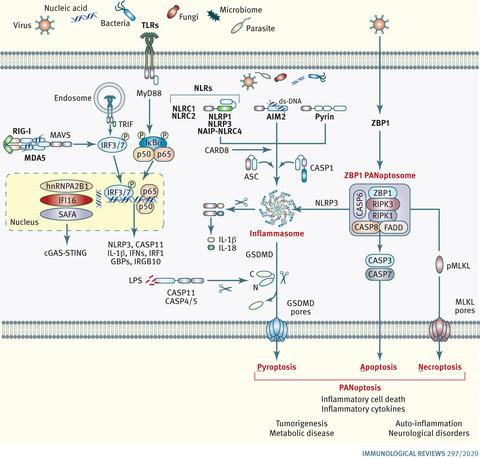Immunological Reviews ( IF 8.7 ) Pub Date : 2020-08-27 , DOI: 10.1111/imr.12912 Thirumala-Devi Kanneganti 1

|
1 INTRODUCTION
The innate immune system is the critical first line of defense against infectious and sterile insults. A cell’s ability to sense these insults relies on a series of germline‐encoded receptors, generally referred to as pattern recognition receptors (PRRs). PRRs are responsible for recognizing unique molecular patterns from microbes known as pathogen‐associated molecular patterns (PAMPs) and endogenous molecules released from damaged and dying cells known as damage‐associated molecular patterns (DAMPs). There are several different PRRs found throughout the cell, including Toll‐like receptors (TLRs), C‐type lectin receptors (CLRs), nucleotide‐binding domain, leucine‐rich repeat‐containing (or NOD‐like) receptors (NLRs), absent in melanoma 2 (AIM2), IFI16, pyrin, Z‐DNA‐binding protein 1 (ZBP1), retinoic acid‐inducible gene I (RIG‐I), MDA5, and many more. PRRs can be found on the membrane, in the cytosol, and in the nucleus. Some PRRs can induce the formation of a multiprotein complex called the inflammasome that leads to the processing and release of the proinflammatory cytokines IL‐1β and IL‐18 and cell death in the form of pyroptosis. Within the NLR family of PRRs, there are some proteins that form an inflammasome, such as NLRP1, NLRP3, and NLRC4, and some that do not, such as NLRC1 and NLRC2 (NOD1 and NOD2). AIM2 and pyrin are also well‐established as sensors that form an inflammasome. Whether they form inflammasomes or not, PRRs are each important for sensing their respective ligands and initiating signaling pathways that drive gene expression, protein production, cytokine and chemokine release, and cell death while also shaping the adaptive immune response, dictating the overall fitness of the immune system.
Within the cell, membrane‐bound PRRs are responsible for sensing external insults, while intracellular cytosolic and nuclear PRRs are essential for detecting intracellular pathogens or alterations in cellular homeostasis. In this issue of Immunological Reviews, we explore the intracellular innate immune receptors, characterizing their sensing and signaling pathways and detailing their diverse roles in health and disease. We also describe the therapeutic implications of modulating these pathways.
中文翻译:

细胞内先天免疫受体:细胞内的生命。
1 介绍
先天免疫系统是抵御传染性和无菌性侵害的关键第一道防线。细胞感知这些损伤的能力依赖于一系列生殖系编码的受体,通常称为模式识别受体 (PRR)。PRR 负责识别来自微生物的独特分子模式,称为病原体相关分子模式 (PAMP),以及从受损和垂死细胞释放的内源性分子,称为损伤相关分子模式 (DAMP)。在整个细胞中发现了几种不同的 PRR,包括 Toll 样受体 (TLR)、C 型凝集素受体 (CLR)、核苷酸结合结构域、富含亮氨酸重复序列(或 NOD 样)受体 (NLR),在黑色素瘤 2 (AIM2)、IFI16、pyrin、Z-DNA 结合蛋白 1 (ZBP1)、视黄酸诱导基因 I (RIG-I)、MDA5、还有很多。PRR 可以在细胞膜、细胞质和细胞核中找到。一些 PRR 可以诱导称为炎症小体的多蛋白复合物的形成,从而导致促炎细胞因子 IL-1β 和 IL-18 的加工和释放以及细胞焦亡形式的死亡。在 PRR 的 NLR 家族中,有一些蛋白质会形成炎性体,例如 NLRP1、NLRP3 和 NLRC4,而另一些则不会,例如 NLRC1 和 NLRC2(NOD1 和 NOD2)。AIM2 和 pyrin 也是公认的形成炎性体的传感器。无论它们是否形成炎性体,PRR 都对感知各自的配体和启动信号通路很重要,这些信号通路驱动基因表达、蛋白质产生、细胞因子和趋化因子释放以及细胞死亡,同时也塑造适应性免疫反应,
在细胞内,膜结合的 PRR 负责感知外部损伤,而细胞内的细胞溶质和核 PRR 对于检测细胞内病原体或细胞内稳态的改变至关重要。在本期免疫学评论中,我们探讨了细胞内先天免疫受体,描述了它们的传感和信号通路,并详细介绍了它们在健康和疾病中的不同作用。我们还描述了调节这些途径的治疗意义。


























 京公网安备 11010802027423号
京公网安备 11010802027423号